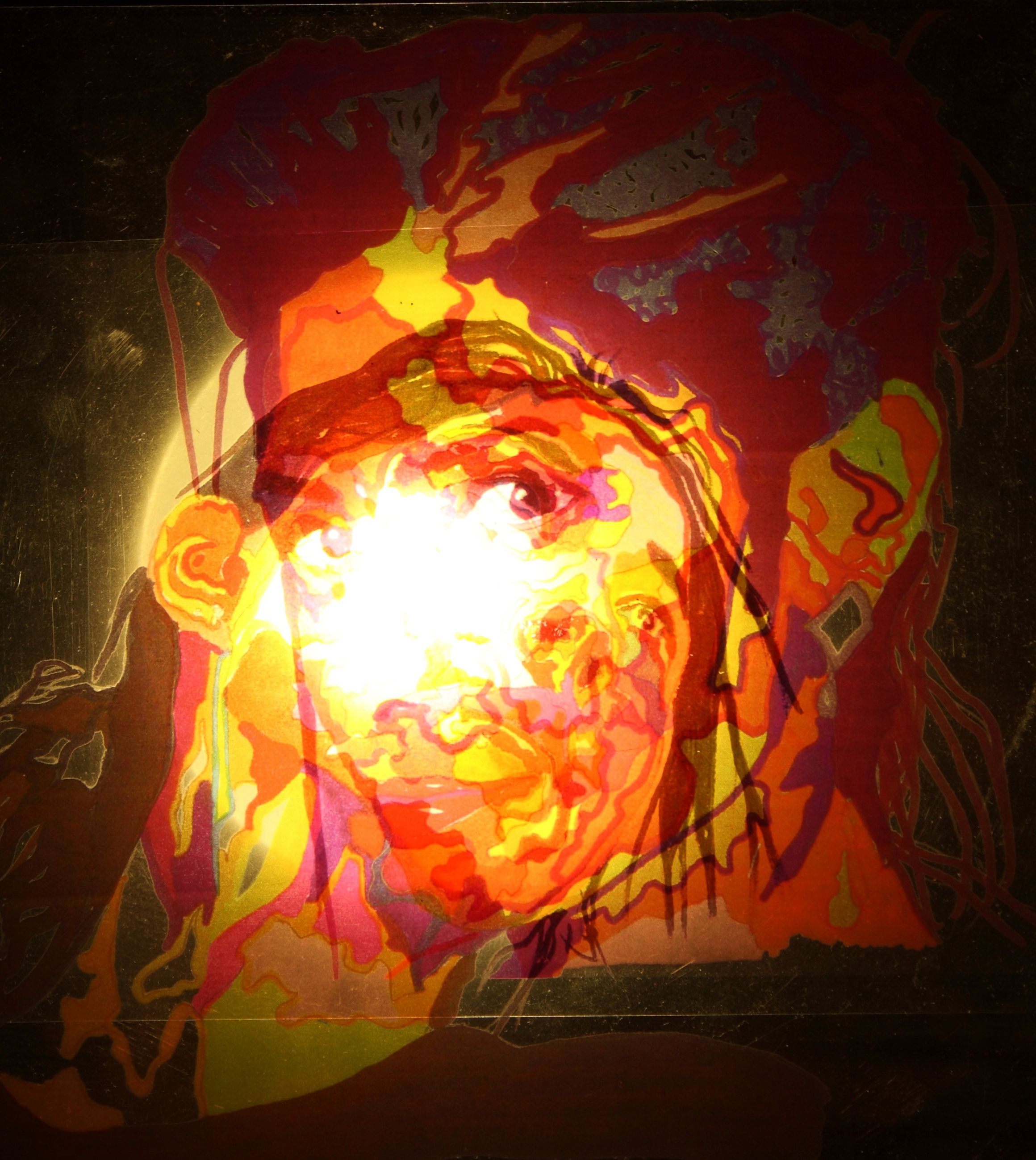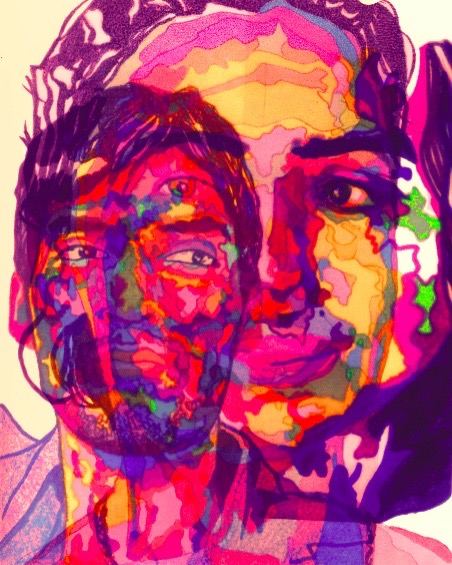Nayha Jehangir Khan, a visual artist based in Islamabad started her career in Pakistan, after being employed at Kuch Khaas in 2010. She has worked as an assistant curator at Rohtas Gallery and Khaas Gallery, Islamabad. After a four month artist residency in Istanbul, Khan devoted all her time to her art practice and has displayed her work at galleries such as My Art World, Islamabad and Paint Bucket, Lahore. Nayha talks to The Missing Slate about her inspirations and the process through which her art pieces are conceived.
Nayha talks to The Missing Slate’s Shameen Arshad about her inspirations and the process through which her art pieces are conceived.
Please tell our readers a little bit about yourself.
I attended York University in Toronto for my Bachelors in Fine Arts (Visual Arts), graduating with Honors in 2010. The program encouraged students to pursue an interdisciplinary understanding of art. Even though I chose a more traditional major, such as painting and drawing, it did not keep me from hybridizing my painting practice by integrating elements of installation art, time-based media and performance. I’ve dabbled in theatre, being trained in lighting and set design. Such an approach to painting practice has often taken me outside my studio and even onto the streets of Istanbul in 2013.
What inspired you to pursue this line? What were the greatest influences that stirred you onto this path?
I come from a family of economists. Being the youngest meant there were many to advise and support me in my future professional decisions, but first I had to convince them! The uncertainty that comes with willingly choosing a non-linear and unconventional career path requires that you take responsibility for your passion. I’d like to think that a young Nayha knew that she wanted to be an artist no matter what.
I would jump at the chance to do all kinds of extracurricular activities during school whether it was debating, volleyball, poetry recitals, and competitions, anything to keep me outside my science classes. After showcasing such communication and interpersonal skills, the natural step in furthering my desire to express myself was diving into an art education. It was the best decision I ever made.
Which artists influenced you the most?Â
My early influences in painting were definitely found during my time in Canada. I also looked up to Mansoor Rahi, one of the first established artists of Pakistan, as a mentor who I was fortunate enough to apprentice during my A-levels. I find the work of Goya, Kandinsky, Munch, Hoffman, Albers and Rothko enchanting and the colour compositions mystical. The majority of masters of art are male, so when I came across the work of Marlene Dumas, I was transfixed and in absolute “fresh-art-student†awe at the powerful imagery she depicts in her portrait and figurative paintings. I think influence requires that one read into another artist’s work with an open mind and an ever observant eye. There is so much to be discovered about your own artwork by constantly engaging with the work of others.
What are the themes that you touch upon in your work?
It’s essential for me to be able to draw a parallel between the decisions made on a canvas and the nature of that decision acting as a reflection of personal life choices. The process of creating a work of art is very similar to how we move forward in our own lives. The act of observation / conception, deconstruction / reconstruction, representation / abstraction, rationale / viewing are theoretical ideas that are transferable methods of understanding ourselves. Most of these themes fall under a larger discourse of understanding “Identity”, not in the political sense but in a more ephemeral sense, a layering, an undertone, the subtext. Painting for me still stands as a valuable, emotive medium constantly flirting with uncovering the human condition. For me portraiture is imbued with a sense of intimacy, these faces are people I’ve interacted with and had many conversations with that have defined my own sense of self over the years.
What is your creative process like?
Oh! I love explaining this because it’s not technical at all! Whenever you listen to a brilliant piece of music, the track ends, but you carry the memory of it. That memory is triggered in your mind at another unrelated remote moment. Similarly, what at the beginning of my creative process feels random — a face or a colour palette — is in fact a resonance or a response to a memory of an experience. It’s only until you’ve spent enough time with that memory or the feeling that the memory triggers within yourself and you can start to formulate a creative rationale.
Which is your most preferred medium?
Oils and acrylics on canvas.
What is the most challenging part of this profession?
Artists throughout the ages have been innovators, futurists, historians – and even today can be versatile by taking on a more chameleon like nature. Artists are visible on social media and boldly guide many a rebellion – they are putting themselves out there politically and/or academically. The idea is to truly believe in your purpose no matter how relatable or alienating it is for others. Artists cannot exist in isolation, they must reach out and share what they know and see. Honestly, the journey is to constantly reveal, and conceal, what you can do for yourself and what you can do for others. Creating and altering perceptions of your viewers. The toughest part is to stay on the journey of constantly searching and experimenting. In Pakistan, artists have much to balance between personal, professional, political, financial, social and cultural topographies that are at times at odds with each other. Our sphere of understanding our environment feels inaccessible compared to our easy global exposure through the Internet. There is a disconnect between what we know about our own local art landscape, and what we think we know to be relevant globally. It’s hard to expand communities for art and culture in Pakistan; we are censored and sensitized to our limitations.
What is the most rewarding aspect of this profession?
Artists will always be a minority, as they solely rely on themselves and their unique understanding of their environment. It’s exciting to have conversations with people that are completely surprised by who you are, but also finding others who share in the joy and pain, that are part and parcel of calling yourself an artist.
How has your style evolved over the years?
Aspiring artists will master many styles of work in hopes of developing a strong portfolio. But later on you start to look for the invisible thread between various techniques. Over the last four years I can see that my drawing, painting, photography, video, academic studies have combined and found a common ground on my canvas. It was the evolution I was hoping for, but I still revisit mediums individually from time to time, as each medium is a source of inspiration.
Are you someone who calculates each move or more of an improviser?
You definitely need to plan, meticulously! A five-year plan, three-year plan, a year-long plan, three-month plan! I had defined artistic goals I wanted to achieve and I took calculated risks. It’s important to acknowledge everything won’t happen exactly the way you’d hope and you have to be prepared to take chances on unexpected opportunities. Recognizing a suitable opportunity is imperative for maintaining healthy studio practice. Don’t let opportunities evaluate you, you should evaluate opportunities! Artists need to balance what they can do and what they don’t need to do. I look for things that excite the creative in me with or without the security of a good payoff. You can have a mixed bag of employment skills like I have, and take on diverse roles of employment so that you can sustain your own art practice, but never let anyone decide the value of your time through a pay cheque or employment title.
What helps you decide whether a certain painting is complete?
Every painter spends some one-on-one time with their work. Sit back, and for added dramatic effect, be silent for a long time. There have been times I’ve touched up paintings on opening night because I saw something and I added a few more brushstrokes.
What is the one event that you would describe as the turning point in your career?
When I started my fourth year at college, I still wasn’t sure if painting was my central medium of choice. I knew my love for modern painting was intensely strong. It wasn’t until the Visual Art Open House, where work was displayed anonymously, and a painting honorarium was to be awarded by a fancy three person, intimidating guest curatorial panel! I realized I was nervous because up until that point I had never gotten that kind of opportunity, to showcase a painting outside of my faculty and peers. Either my art dream bubble was about to burst or I was going to get the affirmation I so desired. I not only won the honorarium, to my absolute surprise the award was a 100 dollars, it felt like a first sale and the best part was I got to keep my painting as a reminder that I could be a painter, a good one.
Do you feel that the art market in Pakistan is ideal to nurturing the countries creative talent? If not why so?
Art in Pakistan has started to depart from a passive to a more actively integrating and interactive scene. Unfortunately, Islamabad has yet to charter this new and exciting territory. When you are based in one city it becomes difficult to create a dialogue for your work. It didn’t help that CDA (Capital Development Authority)* shut down our galleries and now artists like me are looking to more public friendly spaces like restaurants, and preferably art collector’s homes. We face bureaucracy at every turn. And worse still the fate of our art spaces are drowning in a clerical tsunami. My hope is that alternative art spaces and nonprofit galleries will be pioneering a new art scene in the coming years.
Many say that a creation on canvas is a reflection of the artist’s inner self. How impartial, in your opinion, can an artist be when conceiving a work of art?
On the visual surface of a painting, you are reading the compositional decisions of an artist. Once past those obvious compositional choices there lay a deeper reading of the artist’s psyche. You can actually trace back and expose the mind mapping it must have taken for the artist to create that particular piece. Artists will often share their artistic constellation, their sources, and references that helped them navigate and create a piece of art, or they’ll purposely remove any sign of their presence in hopes to present a more objective piece. Both approaches tell us something about the artist. In fact, the responsibility of the artist is to acknowledge that the source of their creativity is themselves, and in that, they share who they are with their audience.
*A division of government in charge of the development of Islamabad as the capital of Pakistan.
Shameen Arshad is an art critic for this magazine.








